Case Study: Immowelt - Seller Leads Business
From what the heck do we know to a clear vision of an user centric and profitable product
Seller what... ??
A major part of the immowelt seller lead business is the property valuation funnel. My mission and aim was to optimize this funnel together with the Team in order to increase conversion rates (B2C) and decrease the cancellation rate of our B2B customers (real estate agents). This is how we approached this mission.


The property valuation is a step-by-step process of requesting various (property) data with the aim of obtaining the user's contact details in the end. These contacts (leads) are sold to real estate agents, who intend to generate mandates from them.
The funnel first asks the user for general data about the property, such as location, size, year of construction, etc.. In the final step, personal data (telephone number and email) is requested from the user in order to
1. send him an email with the estimated value range for his property and
2. to put him in contact with up to three agents, who would assist the owner with the sale.
Landing page of estimation funnel in 2019
First things first:
I took over the user research role in 2019 shortly after a new PO for the immowelt seller lead business started. There was an existing property estimation funnel when we started to collaborate.
Since we couldn't draw on any existing insights, because there had been no research on it at immowelt before, we began to explore. 🕵️♀️
Discovery:
🎯 Objective 1:
Understanding of competition and market situation
⚙️ Methodology:
Competitor Analysis / Benchmarking
We looked at the property valuation processes of our competitors and similar portals and noted, what steps they had in addition to our process or what they did differently from us.
This gave us a good overview of where we stand and how others offer property valuation. However, we still didn't know what our customers (B2C / B2B) thought of our process, who exactly they are and what they need.


🎯 Objective 2:
Understand, who our customers are, which journey they go through, what challenges they occur and what would help them.
⚙️ Methodology:
I used Mixed Methods (qualitative and quantitative) to get more comprehensive answers to our questions:
➡ Interviews B2C with private Home Sellers
➡ User tests with private Home Sellers
➡ Survey with private Home Sellers (Validation of the qualitative findings & hypotheses we created from them)
➡ Interviews B2B (with real estate agents buying seller leads from immowelt)
➡ Telephone survey of converted leads (conducted by the support team)
💡Key Insights:
➡ I identified 4 types of B2C customers:
1. Self sellers
2. With Agent Sellers
3. Returnees (they are With Agent Sellers in the end, but try to organize the sale by themselves first)
4. Undecided (at an early stage of their journey and not sure, which is best for them yet)
From all the information we gathered through interviews and user tests I created audience profiles summarizing the motivations, procedures, pains, needs and emotions for each type.
We found out:
💡➡ A lot of our B2C customers using the estimation funnel don't want contact with agents, they want the free, no obligation property valuation which is announced to them, when they enter the funnel. In addition, many criticized the process as non-transparent, because they are not clearly informed from the beginning, that their contact details will be sent to several agents, who then try to contact them. Moreover the price estimates are criticized as too inaccurate and unrealistic.
💡➡ The result of the unwillingness to get in touch with agents was, that agents (B2B) on the other hand had difficulty reaching the leads sold to them and therefore cancelled many leads. They wanted better pre-qualification, which would put them in touch with people who seriously want and need their help and get them mandates.
Audience Profiles of the 4 Seller Types identified
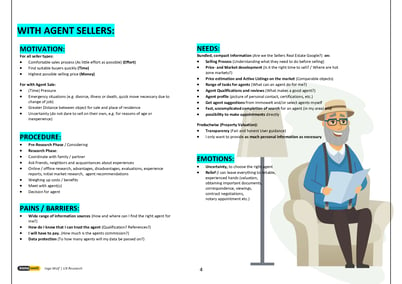
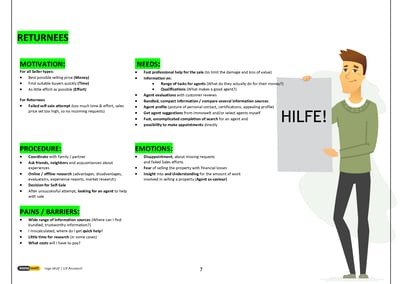






💡➡ The interviews and the seller survey we conducted in close collaboration with our Market Research department also gave us a deeper understanding of the Customer Journey (B2C), which I summarized in a Customer Journey Map. The findings of the survey enabled us to quantify qualitative insights, so that we could put numbers on what we found out.


Now that we knew, who our customers are, what their journey and challenges are and what they need, we could enter the next stage.
Customer Journey Map - with agent property sales
Refine & Design:
🎯 Objectives:
1. Matching of Customer Needs and Status Quo of product
2. Ideation for optimization of the property estimation funnel based on the gained insights
⚙️ Methodology:
➡ Value Proposition Design Workshop
➡ Paper Prototyping
In order to align and define how our product brings value to the B2C customers, we used the Value Proposition Canvas, as a way of matching the customer needs and the value our product was already delivering. In that way, we could identify missing links and see, where we had to optimize.
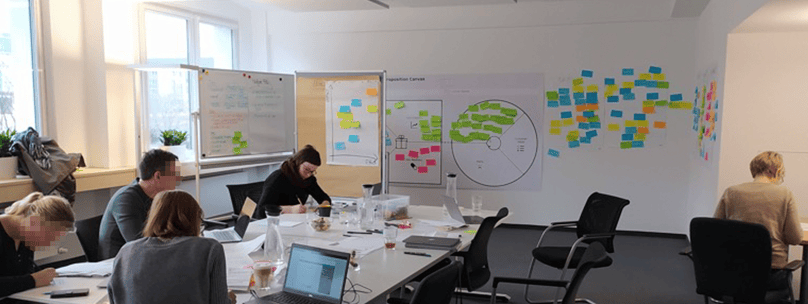

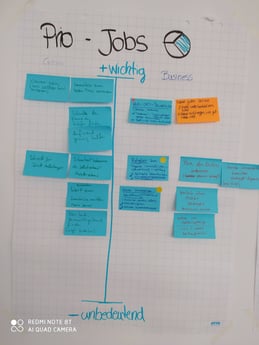





We looked at what Jobs (functional, social, emotional), Pains and Gains the user has in the property valuation process and to what extent the status quo of our funnel already fulfilled these aspects.
In the next steps, we took another look at our competitors and collected ideas on how to optimize the property valuation process. After a dot voting on the ideas, we sorted the best ones into an impact/effort matrix.
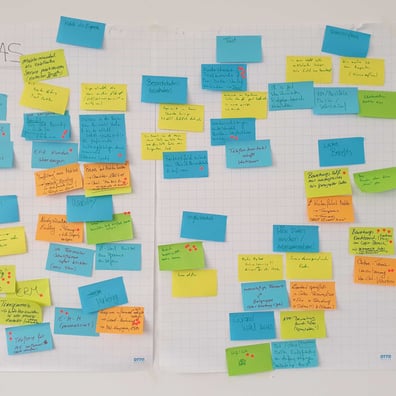

Conceptualizing and Paper Prototyping
After we had a clear overview, of where our process needed improvement, we startet concepting and paper prototyping. We dot-voted on the best elements of our drafts and UX concept took over from there, translating our scribbles into a proper UI and building a prototype, we could then test on real users.
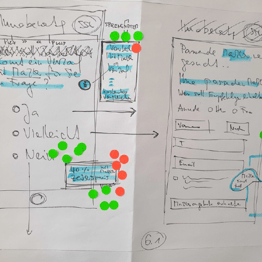

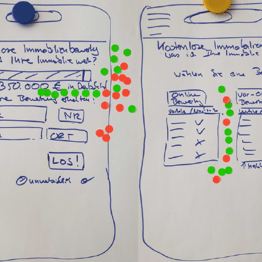
PROTOTYPE & TEST:
🎯 Objectives:
1. Creating a Prototype of the property estimation funnel including our new step
2. Testing this click dummy on real users to validate our ideas
We used a HiFi-Prototype to test it during our regular test format Test'n'Coffee, where we invite 5 participants to test with each for 15 min.
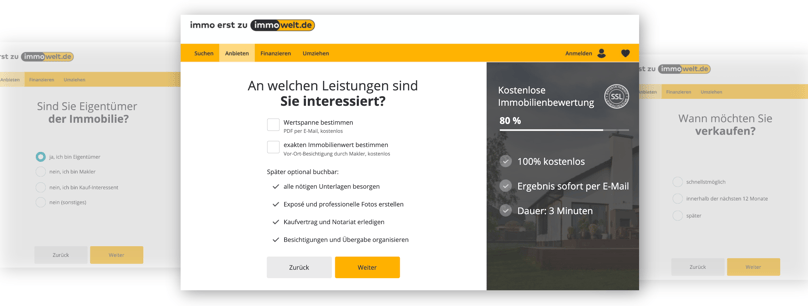
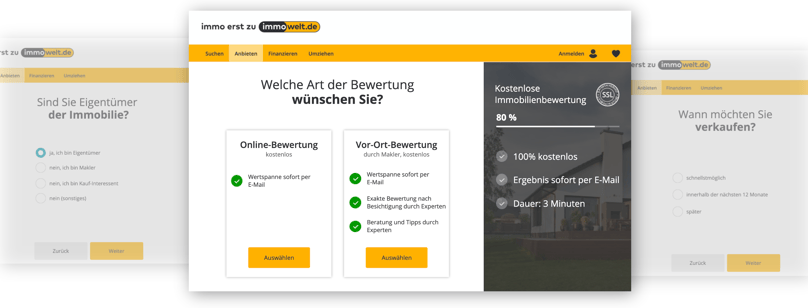


The test showed that the new intermediate step that asks whether agent contact is desired or not was very well received. The early introduction of the real estate agent within the flow contributes to more transparency and fairness of the process, plus it increases the quality of our leads, as only seriously interested sellers get in touch with the agent.
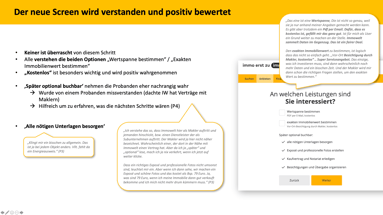
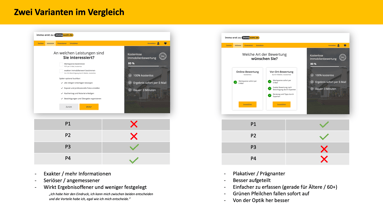
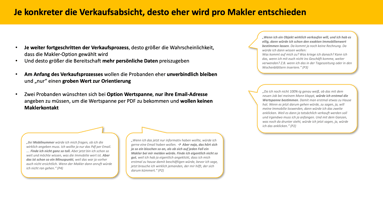
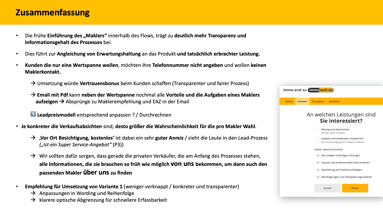




Learnings & OutLOOK:
In the course of this research and design process, we arrived at a fairly clear vision of a property valuation process that meets the needs of our customers and can be profitable. Next to the ideas above, that we tested, where we basically ask our users whether they want Agent contact or not, we also implemented some quick win solutions.
B2B
What became very clear during the whole Research process was, that we need a shift from lead quantity to a better lead quality. As a first measure in this direction, we have introduced the m-tan procedure, with which we verify the contact's telephone number.
This reduced our overall lead numbers, but it also reduced our cancellation rate by 20% as more leads we sell to agents are now actually reachable.
To increase lead quality, we also added some filter questions. (Do you want to buy / sell | Are you an owner / seeker / agent | When do you want to sell? (asap / within next 12 months / later - the sooner, the more relevant for agents)).
B2C
To increase transparency for our B2C clients, we have added an additional step, where we communicate the benefits of selling with an agent, as well as the next steps in the process.
But of course, this does not change the fact that some of our B2C clients, for certain reasons, do not want any contact with agents and still have no way of avoiding this contact in our property valuation process.
Conclusion and outlook
Our vision of a good, transparent and fair process involves to ask whether the help of an agent is desired in the first place. Only if this question is answered with yes, the contact should be forwarded to an agent. In addition, customers should be asked whether they want to select agents themselves from a list or whether they want agent recommendations from Immowelt.
The implementation of this vision is not yet complete and is constrained by some short term business objectives, that can't be missed.
A prudent change in our business model / lead payment model is needed to meet the set revenue targets and to achieve the shift from quantity to quality in our offering.
However with the support of the shown research measures and findings, the team now has the vision clearly in mind, is aligned to it and is working towards it step by step.